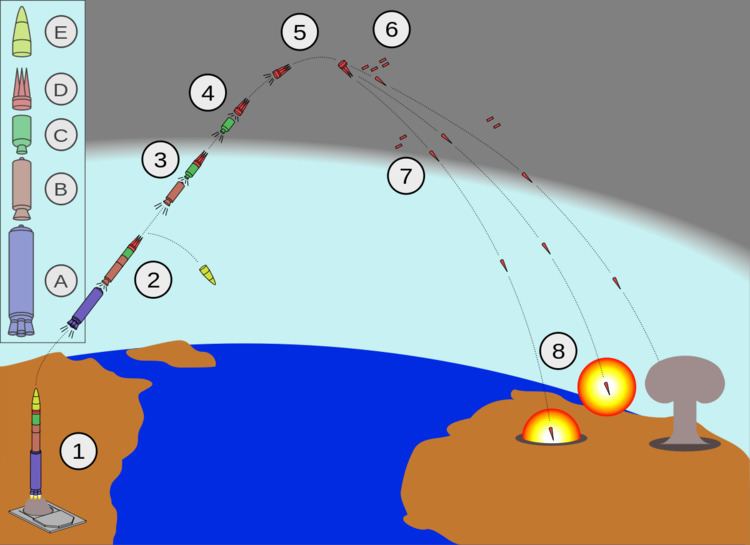 | ||
A ballistic missile is a missile that follows a ballistic trajectory with the objective of delivering one or more warheads to a predetermined target. A ballistic missile is only guided during relatively brief periods of flight (there are unguided ballistic missiles as well, such as 9K52 Luna-M, although these may well be considered rockets), and most of its trajectory is unpowered and governed by gravity and air resistance if in the atmosphere. This contrasts to a cruise missile, which is aerodynamically guided in powered flight. Long range intercontinental ballistic missiles (ICBM) are launched on a sub-orbital flight trajectory and spend most of their flight out of the atmosphere. Shorter range ballistic missiles stay within the Earth's atmosphere.
Contents
History
The earliest use of rockets as a weapon date to the 13th Century (see History of rockets). A pioneer ballistic missile was the A-4, commonly known as the V-2 rocket developed by Nazi Germany in the 1930s and 1940s under the direction of Wernher von Braun. The first successful launch of a V-2 was on October 3, 1942, and it began operation on September 6, 1944 against Paris, followed by an attack on London two days later. By the end of World War II in May 1945, over 3,000 V-2s had been launched.
The R-7 Semyorka was the first intercontinental ballistic missile.
A total of 30 nations have deployed operational ballistic missiles. Development continues with around 100 ballistic missile flight tests in 2007 (not including those of the US), mostly by China, Iran, and the Russian Federation. In 2010, the U.S. and Russian governments signed a treaty to reduce their inventory of intercontinental ballistic missiles (ICBMs) over a seven-year period (to 2017) to 1550 units each.
Flight
An intercontinental ballistic missile trajectory consists of three parts: the powered flight portion; the free-flight portion, which constitutes most of the flight time; and the re-entry phase, where the missile re-enters the Earth's atmosphere. (The flight phases for shorter-range ballistic missiles are essentially the first two phases of the ICBM, as some ballistic categories do not leave the atmosphere.)
Ballistic missiles can be launched from fixed sites or mobile launchers, including vehicles (e.g., transporter erector launchers (TELs)), aircraft, ships, and submarines. The powered flight portion can last from a few tenths of seconds to several minutes and can consist of multiple rocket stages.
When in space and no more thrust is provided, the missile enters free-flight. In order to cover large distances, ballistic missiles are usually launched into a high sub-orbital spaceflight; for intercontinental missiles, the highest altitude (apogee) reached during free-flight is about 1,200 kilometers (750 mi).
The re-entry stage begins at an altitude where atmospheric drag plays a significant part in missile trajectory, and lasts until missile impact.
Advantages
The course taken by ballistic missiles has two significant desirable properties. First, ballistic missiles that fly above the atmosphere have a much longer range than would be possible for cruise missiles of the same size. Powered rocket flight through thousands of kilometers of air would require vastly greater amounts of fuel, making the launch vehicles larger and easier to detect and intercept. Powered missiles that can cover similar ranges, such as cruise missiles, do not use rocket motors for the majority of their flight, but instead use more economical jet engines. Despite this, cruise missiles have not made ballistic missiles obsolete, due to the second major advantage: Ballistic missiles can travel extremely quickly along their flight path. An ICBM can strike a target within a 10,000 km range in about 30 to 35 minutes. With terminal speeds of over 5,000 m/s, ballistic missiles are much harder to intercept than cruise missiles, due to the much shorter time available to intercept them. This is why ballistic missiles are some of the most feared weapons available, despite the fact that cruise missiles are cheaper, more mobile, and more versatile.
Missile types
Ballistic missiles can vary widely in range and use, and are often divided into categories based on range. Various schemes are used by different countries to categorize the ranges of ballistic missiles:
Tactical, short- and medium-range missiles are often collectively referred to as tactical and theatre ballistic missiles, respectively. Long- and medium-range ballistic missiles are generally designed to deliver nuclear weapons because their payload is too limited for conventional explosives to be cost-effective in comparison to conventional bomber aircraft (though the U.S. is evaluating the idea of a conventionally armed ICBM for near-instant global air strike capability, despite the high costs).
Quasi ballistic missiles
A quasi ballistic missile (also called a semi ballistic missile) including anti-ship ballistic missiles is a category of missile that has a low trajectory and/or is largely ballistic but can perform maneuvers in flight or make unexpected changes in direction and range.
At a lower trajectory than a ballistic missile, a quasi ballistic missile can maintain higher speed, thus allowing its target less time to react to the attack, at the cost of reduced range.
The Russian Iskander is a quasi ballistic missile. The Russian Iskander-M cruises at hypersonic speed of 2,100–2,600 m/s (Mach 6 - 7) at a height of 50 km. The Iskander-M weighs 4,615 kg carries a warhead of 710 – 800 kg, has a range of 480 km and achieves a CEP of 5 – 7 meters. During flight it can maneuver at different altitudes and trajectories to evade anti-ballistic missiles.
China, India & Iran have recently developed anti-ship ballistic missile;
Comparable systems
